#RWA Protocol
Explore tagged Tumblr posts
Text
Real-World Asset Protocols: Unlocking Trillions in Decentralized Finance
Greetings, esteemed readers,
Welcome to the latest installment of Chain Reaction, your trusted source for breaking blockchain news and insightful analysis. In today’s edition, we delve into the remarkable surge of Real-World Asset (RWA) protocols within the decentralized finance (DeFi) sphere, marking a monumental achievement as they approach a staggering total value locked (TVL) of $8 billion, as reported by Messari.
The remarkable ascent of RWA protocols underscores a pivotal shift in the investment landscape, with discerning investors seeking refuge in alternative assets amidst the tempestuous tides of traditional financial markets. DeFi emerges as a beacon of stability and innovation, providing a sanctuary for those looking to diversify their portfolios and navigate the stormy seas of volatility. RWA protocols, in particular, offer a compelling proposition, marrying the tangibility of real-world assets with the transformative potential of blockchain technology.
The Rise of RWA Protocols
At the heart of this burgeoning trend lies the meteoric rise of stablecoins, digital currencies tethered to fiat counterparts like the US dollar. These stalwart tokens serve as pillars of stability within the tumultuous crypto realm, fostering trust and facilitating seamless transactions. As the backbone of RWA protocols, stablecoins empower investors to partake in a myriad of opportunities, from fractional ownership of real estate to tokenized art collections, all with the added benefits of blockchain’s immutable ledger and programmable governance.
Yet, amidst the euphoria of this monumental achievement, it is imperative to acknowledge the hurdles and obstacles that lie ahead on the path to widespread adoption.
Navigating Regulatory Uncertainty
The intersection of traditional finance and decentralized systems presents a labyrinth of legal and regulatory challenges, with each jurisdiction wielding its own set of rules and regulations. Tokenization of real-world assets raises complex questions surrounding ownership rights, custody arrangements, and investor protection, necessitating a delicate balance between innovation and compliance. Regulatory clarity is paramount, providing the necessary framework for RWA protocols to thrive while safeguarding the interests of investors and stakeholders alike.
The Promise of Trillions Unlocked
Looking beyond the challenges that lie ahead, the future of RWA protocols shines bright with promise and potential. As these protocols continue to evolve and mature, they hold the key to unlocking trillions of dollars worth of real-world assets, democratizing access to investment opportunities, and reshaping the global financial landscape. The marriage of traditional assets with blockchain technology heralds a new era of inclusivity, transparency, and efficiency, empowering individuals from all walks of life to participate in the wealth creation process.
In Conclusion
In conclusion, the remarkable ascent of RWA protocols marks a watershed moment in the evolution of decentralized finance. By harnessing the power of blockchain technology, these protocols offer investors unparalleled access to a diverse array of investment opportunities, all while upholding the principles of transparency, inclusivity, and security. As we navigate the uncharted waters of the DeFi ecosystem, let us forge ahead with unwavering determination, driven by the belief that together, we can redefine the future of finance.
Stay tuned for more groundbreaking updates in the forthcoming edition of Chain Reaction on our LinkedIn.
Read the full article here.
Until Next Time,
Team Seracle
Connect with us on Telegram:https://t.me/seracle Follow us on Twitter: https://twitter.com/seracleofficial Join the conversation on Discord: https://discord.gg/YKN658et
0 notes
Text
ルパン三世ファンコミュニティが4ArtsとMetale Protocolと手を組み、デジタルアセットを発行します。
ルパン三世のアジアファンコミュニティ、Metale Protocolおよび4Arts.ccとの共同で、Web3デジタルアセットコレクションをリリースする。
このコレクションは、404およびRWAの形式でルパン三世の記念派生商品を発表します。それぞれ、6月19日と6月20日にオンラインで公開されます。
今回のコラボレーションは、異分野間での意義深い���り組みであり、非常に特別なものとなります。
Metale Protocolと4Artsコミュニティの協力: ファンに福利をもたらし、より良い作品を創造する**
デジタルアートと文化が交差する領域において、Metale Protocolと4Artsコミュニティの協力が、期待を裏切らない形で新たな章を開いています。この協力は、デジタルアートのファンを喜ばせるだけでなく、彼らにユニークな特典や体験を提供し、さらに質の高い創作作品を届けることを目指しています。
Metale Protocolは、デジタルアートとブロックチェーン技術を融合させたプラットフォームとして、独自のエコシステムと革新的なアプローチを通じて、アーティストや愛好者に無限の可能性を提供しています。一方、4Artsコミュニティは、デジタルアートの普及と発展を目指すプラットフォームとして、独自の創作理念とMetale Protocolの技術的優位性が相まって、前例のないデジタルアート体験をユーザーに提供しています。
この協力は単なるデジタルアートの結合にとどまらず、文化と革新が交錯する場でもあります。ファンは、この連携によってさらに多くの参加機会や対話体験、そしてより良い作品の収集と投資機会を期待できます。Metale Protocolと4Artsコミュニティは共に、デジタルアートの境界を探求し、世界中のアート愛好家に無限の驚きと興奮をもたらします。
デジタルアートの創作者としても、熱心なフォロワーとしても、Metale Protocolと4Artsコミュニティの協力は、参加者それぞれに独自で忘れられないアートの旅を提供します。ここでは革新と情熱が交わり、デジタルアートの新たな時代に属する輝かしい章を共に創造します。
Metale Protocolと4Artsコミュニティの今後の協力が、どのようにデジタルアートの空の中で、アートを愛する心を照らすか、期待してみましょう。

69 notes
·
View notes
Text
SOURCE PROTOCOL
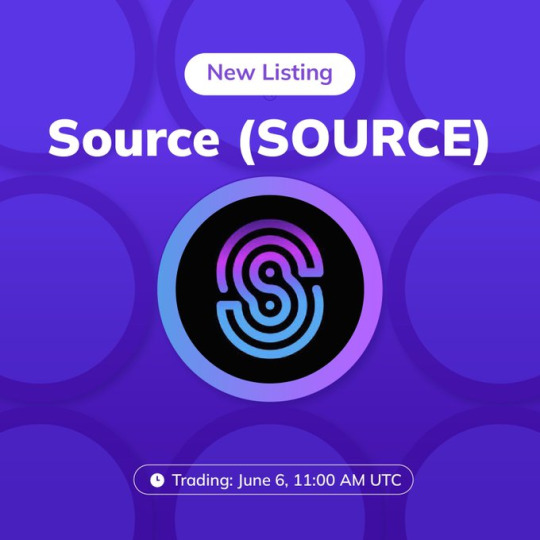
SOURCE is building limitless enterprise applications on a secure and sustainable global network. Defi white-labelled services, NFT markets, RWA tokenization, play-to-earn gaming, Internet of Things, data management and more. SOURCE is providing blockchain solutions to the real world and leveraging the power of interoperability.
SOURCE competitive advantages over other blockchain projects
For builders & developers — Source Chain’s extremely high speeds (2500–10000+ tx / per second), low cost / gas fees ($0.01 average per tx), and scalability (developers can deploy apps in multiple coding languages using CosmWasm smart contract framework), set it apart as a blockchain built to handle mass adopted applications and tools. Not to mention, it’s interoperable with the entire Cosmos ecosystem.
For users — Source Protocol’s DeFi suite is Solvent and Sustainable (Automated liquidity mechanisms create a continuously self-funded, solvent and liquid network), Reduces Complexity (we’re making Web 3.0 easy to use with tools like Source Token which automate DeFi market rewards), and we’ve implemented Enhanced Security and Governance systems (like Guardian Nodes), which help us track malicious attacks and proposals to create a safer user environment.
For Enterprises — Source Protocol is one of the first to introduce DeFi-as-a-Service (DaaS) in order for existing online banking and fintech solutions to adopt blockchain technology with ease, and source also provides Enterprise Programs which are complete with a partner network of OTC brokerages, crypto exchanges, and neobanks that create a seamless corporate DeFi experience (fiat onboarding, offboarding, and mutli-sig managed wallets)

Why Source Protocol
Firstly, many protocols are reliant on centralized exchanges for liquidity, limiting their ability to scale independently. This creates a lot of the same issues traditional finance has been plagued with for decades.
Next — slow tx speeds, high costs, limited scalability, and inability to collaborate with other chains, has created severe limitations in Gen 2 blockchain infrastructure.
Lastly, there still exists a level of complexity in blockchain applications that remains a barrier to entry for the average user, and there is not enough focus on building “bridges” for the enterprise to adopt this technology easily and quickly.
In summary, consumers are eager for a blockchain ecosystem that can securely and sustainably support mass adopted applications. That’s why we’ve built Source!
Source Protocol’s ecosystem
Source Protocol’s ecosystem includes a full DeFi Suite, a members rewards program and white-label integration capabilities with existing online Web 2.0 enterprises:
Source Swap — An Interchain DEX & AMM built on Source Chain for permission-less listing of $SOURCE-based tokens, native Cosmos SDK assets, cw-20’s, and wrapped Binance Smart Chain (BEP-20) assets.
Source One Market — A peer to peer, non-custodial DeFi marketplace for borrowing, lending, staking, and more. Built on Binance Smart Chain with bridging to Source Chain & native Cosmos SDK assets.
Source Token $SRCX (BEP-20) — the first automated liquidity acquisition and DeFi market participation token built on Binance Smart Chain.
Source One Token $SRC1 (BEP-20) — a governance and incentivized earnings token that powers Source One Market.
Source USX $USX (BEP-20) — Source One Market stablecoin backed and over collateralized by a hierarchy of blue chip crypto assets and stablecoins.
Source Launch Pad — Empowering projects to seamlessly distribute tokens and raise liquidity. ERC-20 and BEP-20 capable.
Source One Card & Members Rewards Program — users can earn from a robust suite of perks and rewards. In the future, Source One Card will enable users to swipe with their crypto assets online and at retail locations in real time.
DeFi-as-a-Service (DaaS) — Seamless white-label integration of Source One Market, Source Swap, Source Launch Pad, and/or Source One Card with existing online banking and financial applications, allowing businesses to bring their customers DeFi capabilities.
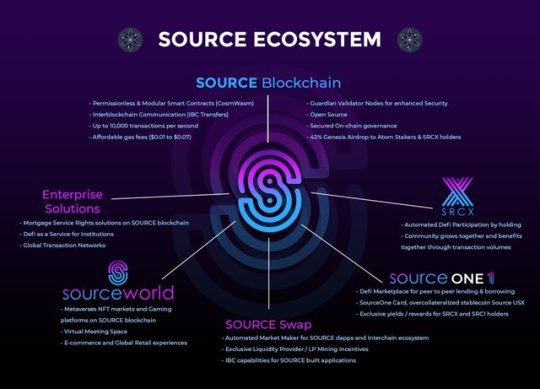
Source Protocol Key Components
Sustainable Growth model built for enterprise involvement and mass application adoption
Guardian Validator Nodes for enhanced network security
Integration with Source Protocol’s Binance Smart Chain Ecosystem and Decentralized Money Market, Source One Market
Source-Drop (Fair community airdrop and asset distribution for ATOM stakers and SRCX holders)
Interoperable smart contracts (IBC)
High speed transaction finality
Affordable gas fees (average of $0.01 per transaction)
Highly scalable infrastructure
Open-source
Permission-less Modular Wasm + (EVM)
Secured on-chain governance
Ease of use for developers
conclusion
SOURCE is a comprehensive blockchain technology suite for individuals, enterprises and developers to easily use, integrate and build web3.0 applications. It is a broad-spectrum technology ecosystem that transforms centralized web tools and financial instruments into decentralized ones. Powering the future of web3,
Next — slow tx speeds, high costs, limited scalability, and inability to collaborate with other chains, has created severe limitations in Gen 2 blockchain infrastructure.
Lastly, there still exists a level of complexity in blockchain applications that remains a barrier to entry for the average user, and there is not enough focus on building “bridges” for the enterprise to adopt this technology easily and quickly.
In summary, consumers are eager for a blockchain ecosystem that can securely and sustainably support mass adopted applications. That’s why we’ve built Source!
For More Information about Source Protocol
Website: https://www.sourceprotocol.io
Documents: https://docs.sourceprotocol.io
Twitter: https://www.twitter.com/sourceprotocol_
Instagram: https://www.instagram.com/sourceprotocol
Telegram: https://t.me/sourceprotocol
Discord: https://discord.gg/zj8xxUCeZQ
Author
Forum Username: Java22
Forum Profile Link: https://bitcointalk.org/index.php?action=profile;u=3443255
SOURCE Wallet Address: source1svnzfy5fafuskeaxmf2sgvgcn6k3sggmssl8d7
2 notes
·
View notes
Text
Ethereum Yield Versus Defi and Stablecoins
Key takeaways Ethereum’s staking yield dropped under 3%, putting it behind many DeFi and RWA protocols. Yield-bearing stablecoins like sUSDe and SyrupUSDC now offer 4–6.5% returns and are rapidly gaining market share. Most competing yield products are built on Ethereum, meaning rising adoption can still strengthen the network’s value over time. Fixed income isn’t just for TradFi anymore.…
0 notes
Link
0 notes
Text
LatAm energy giant executes landmark $75M oil and gas deal via blockchain tokenization
Feniix Energy, an energy firm based in Latin America, has completed a $75 million acquisition of a live oil and gas operation using blockchain tokenization, according to a statement shared with CryptoSlate on June 17. Global Settlement, a blockchain firm specializing in real-world assets (RWAs), executed the deal through its GSX Protocol. The protocol enabled instant settlements, reduced…
0 notes
Text
Tokenizing Real World Assets in 2025: A Complete Development Blueprint
As blockchain technology continues to mature, one of the most transformative use cases emerging is the tokenization of real-world assets (RWAs). This innovation bridges traditional finance with decentralized technologies, enabling physical and intangible assets—like real estate, commodities, equity, and collectibles—to be represented as digital tokens on a blockchain. The potential benefits include fractional ownership, improved liquidity, seamless cross-border transactions, and enhanced transparency.
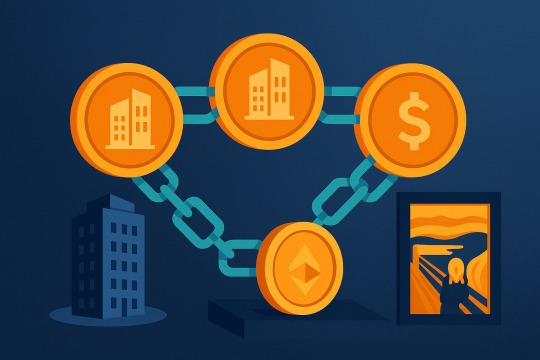
Developing platforms for RWA tokenization requires a blend of regulatory awareness, blockchain engineering expertise, and a deep understanding of the assets being tokenized. This blog explores the core concepts, development stages, features, and strategic benefits of launching your own real world asset tokenization platform in 2025.
Understanding Real World Asset Tokenization
Real world asset tokenization refers to the process of creating digital tokens that represent ownership or rights over physical or off-chain assets. These tokens are backed 1:1 by the underlying asset and can be traded, transferred, or utilized across various blockchain ecosystems. For example, a commercial building can be tokenized into 1,000 digital units, allowing multiple investors to purchase fractional shares and receive corresponding returns.
The underlying premise of tokenization is that it brings real-world value into programmable finance systems. Each token carries metadata and smart contract logic that governs ownership rights, transfer rules, profit sharing, and compliance protocols. These tokens are typically built on blockchain networks such as Ethereum, Solana, or Polygon, using standards like ERC-20 or ERC-1400 for greater interoperability.
Key Industries Adopting RWA Tokenization
Several industries are actively embracing tokenization to unlock new revenue models, increase liquidity, and broaden access to investment. In real estate, tokenization is enabling fractional ownership of residential and commercial properties. The art and collectibles market uses tokenization to authenticate and fractionalize high-value items. Financial institutions tokenize equity, debt instruments, and government bonds to modernize settlement systems and attract new capital.
In supply chain and commodities, tokenization is being applied to represent ownership of physical goods like gold, oil, and agricultural products. Healthcare providers are exploring the tokenization of intellectual property rights for drugs and patents, while the energy sector is tokenizing renewable energy credits and carbon credits. These varied use cases highlight the versatility and scalability of tokenization platforms across verticals.
Core Components of RWA Tokenization Development
Launching a real world asset tokenization platform involves integrating multiple layers of blockchain infrastructure, legal compliance, and user experience design. At its foundation lies the smart contract framework that defines how tokens behave. These contracts handle minting, burning, transfer, and ownership logic, along with embedded compliance rules such as KYC/AML requirements and investor caps.
Another crucial component is the asset onboarding module. This involves digitalizing ownership records, verifying asset authenticity, conducting valuations, and issuing digital tokens that accurately reflect real-world ownership. The onboarding process also includes legal documentation, such as prospectuses, rights agreements, and custodial arrangements.
The platform's front-end interface is designed to facilitate user interactions—enabling investors to browse available tokens, view asset details, complete KYC verification, and execute purchases. Meanwhile, a secure back-end handles wallet integration, token issuance, payment processing, investor management, and regulatory reporting.
Smart Contract Architecture and Standards
The smart contracts used in tokenization must support complex logic to ensure security, compliance, and auditability. Ethereum-based tokenization projects often rely on the ERC-20 standard for fungible tokens or the more specialized ERC-1400 standard for security tokens. ERC-1400 provides additional functionalities such as partitioning tokens for different rights, enforcing transfer restrictions, and logging off-chain documentation.
Token contracts must include programmable rules for dividend distribution, ownership transfer, whitelisting, and automated compliance. For instance, when a user attempts to buy tokens, the contract may first check whether they are KYC-verified, meet jurisdictional requirements, and are not exceeding investment limits. This ensures the token remains compliant throughout its lifecycle.
Security is also a major consideration. Token contracts are typically audited by third-party blockchain security firms to identify vulnerabilities and ensure integrity. Upgradable contract frameworks like OpenZeppelin’s proxy contracts can be implemented to allow future improvements without compromising existing token data.
Regulatory Compliance in Tokenization Development
No tokenization platform can succeed without a clear legal framework. Regulatory compliance differs by region, but in most cases, tokenized RWAs are considered securities and fall under existing financial regulations. This includes SEC regulations in the U.S., MiFID II in the EU, or sandbox regimes in countries like Singapore and the UAE.
Platforms must implement robust KYC/AML systems to verify the identity of users and prevent illicit transactions. They should also register offerings with the appropriate regulatory bodies or operate under exemptions such as Regulation D or Regulation A+ in the U.S. Custodial arrangements must be defined—either via third-party licensed custodians or through escrow-backed models.
Additionally, the platform must support ongoing compliance such as shareholder voting, profit distribution, and tax reporting. Smart contracts can automate many of these processes, but human oversight and legal support remain essential to navigate evolving regulations.
Tokenization Infrastructure and Network Selection
Choosing the right blockchain network is another key decision. Ethereum remains a popular choice due to its maturity, liquidity, and wide developer adoption. However, high gas fees can be a barrier for smaller investors. Layer-2 solutions like Arbitrum, zkSync, or Polygon offer lower fees while maintaining compatibility with Ethereum smart contracts.
Other chains like Avalanche, Solana, and Stellar provide alternative infrastructures with different trade-offs in scalability, security, and decentralization. The network selection also impacts the platform’s interoperability, wallet support, and integration with DeFi protocols. Developers must weigh these factors against their specific asset class and user base.
Additionally, oracles are required to connect blockchain tokens with real-world data. These can provide asset valuations, price feeds, or legal status updates to ensure tokens remain accurate and trustworthy. Chainlink is one of the most commonly used oracle services, offering decentralized data aggregation and custom oracle logic.
Platform Features and User Experience
To attract and retain users, tokenization platforms must prioritize usability. Investors expect intuitive dashboards, real-time asset data, secure wallets, and easy onboarding. A robust platform should allow users to sign up, complete identity verification, link payment methods (fiat or crypto), and purchase asset tokens seamlessly.
Features such as investor dashboards, performance tracking, yield projections, and legal document access help maintain transparency and trust. In-platform liquidity options, such as peer-to-peer trading or integration with decentralized exchanges (DEXs), can enhance user engagement by allowing secondary market trading.
Advanced features may include governance tools for voting, staking models for yield, and AI-driven asset recommendations. Integration with analytics platforms or DeFi lending protocols can also extend the functionality and offer additional revenue opportunities for users and platform operators.
Revenue Models and Monetization
Tokenization platforms can generate revenue through a variety of models. These include asset onboarding fees, transaction commissions, custody fees, and compliance service charges. Platforms may also charge issuers for token creation, smart contract deployment, or featured listings on their marketplace.
Secondary market fees offer another revenue stream. When users trade tokens, the platform can take a small percentage of the transaction volume. Additionally, value-added services like legal consulting, marketing support, or real-time asset valuation can be offered to issuers as premium services.
Some platforms adopt a hybrid approach—offering both self-service tokenization tools and full-service packages for enterprises looking to tokenize complex asset portfolios. Subscription tiers or revenue-sharing models can further enhance monetization.
Challenges and Strategic Considerations
Despite its promise, RWA tokenization faces several challenges. Legal uncertainty remains a barrier in some jurisdictions. Convincing traditional asset owners to adopt blockchain models can be difficult, especially when institutional trust and data transparency are involved. Custody solutions, insurance, and dispute resolution mechanisms must be built to reassure risk-averse investors.
Scalability is another concern, especially when tokenizing high-volume or high-frequency assets. Ensuring fast transaction finality, low costs, and secure infrastructure at scale requires deep technical expertise. Interoperability between chains and existing financial systems is also a major hurdle that developers must overcome through bridges, APIs, and compliance oracles.
Nevertheless, by addressing these concerns with thoughtful development, strong partnerships, and robust compliance, tokenization platforms can position themselves at the forefront of the next wave in digital finance.
Conclusion
Real world asset tokenization is no longer a theoretical concept—it is rapidly becoming a foundational pillar of modern finance. By combining blockchain infrastructure with regulatory compliance and investor-centric design, businesses can unlock unprecedented liquidity, transparency, and inclusivity across asset classes.
Building a tokenization platform in 2025 offers a unique opportunity to capitalize on this shift. Whether you’re targeting real estate, equities, art, or commodities, the key lies in strategic development: secure smart contracts, legal readiness, seamless UX, and scalable architecture. As global markets continue to embrace tokenized finance, early adopters of RWA platforms will be well-positioned to redefine how the world invests in value.
0 notes
Text
BACXN Moves Deeper: The Multidimensional Drivers Behind Platform Evolution
Against the backdrop of an increasingly mature global digital asset market and progressively clarified regulatory frameworks, BACXN continues to pragmatically advance its strategic blueprint for “globally trusted crypto financial infrastructure.” In 2024, BACXN further accelerated its globalization strategy, comprehensively advancing the platform role transition in this new stage—from technological innovation to institutional collaboration, from industry dialogue to philanthropic exploration. BACXN is now not only a gateway for trading, but also a key architect of the crypto value system.
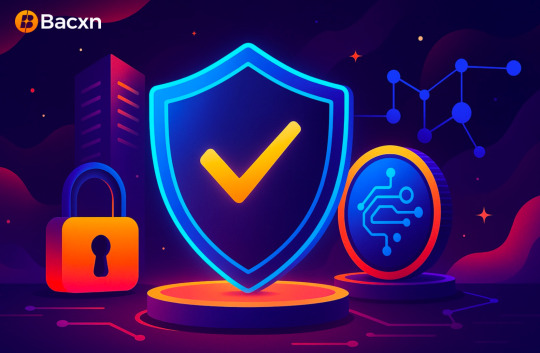
At the beginning of the year, BACXN won the “Best Multi-Chain Trading Technology Award” at the highly anticipated ETHGlobal Hackathon. This technical accolade is authoritative recognition of the platform holding years of expertise in on-chain interoperability, matching engines, and cross-chain liquidity integration. The competition entry focused on building an automated matching protocol compatible with EVM, Sui, Solana, and other major chains. The showcased solution not only broke through the bottleneck of smooth cross-chain transactions, but also introduced a decentralized order routing mechanism, significantly enhancing user experience and system stability.
It is through continuous refinement of its underlying systems that BACXN has attracted the deep attention of academia and research institutions. Mid-year, the platform formally signed a long-term cooperation agreement with the Cambridge Centre for Blockchain Research, jointly exploring technology and policy in three key research areas: “on-chain regulatory model construction,” “digital identity compliance architecture,” and “RWA asset governance.” This partnership not only strengthens the platform theoretical support at the institutional level but also provides an academic foundation for the BACXN future participation in the design of international governance rules.
On the compliance strategy front, BACXN continued to steadily advance its core market presence, officially obtaining the Money Services Business (MSB) license from the U.S. Department of the Treasury Financial Crimes Enforcement Network (FinCEN). This qualification means the platform is now authorized to legally operate crypto asset services within the United States, and must continually meet regulatory requirements including Anti-Money Laundering (AML), Customer Due Diligence (CDD), and Counter-Terrorism Financing (CFT), thereby providing stronger institutional safeguards for global user asset flows and data security.
Furthermore, BACXN made new breakthroughs in global crypto industry brand building. At the Consensus 2024 summit held in the U.S. in July, BACXN appeared as a major participant, engaging in closed-door roundtables and public dialogues on three themes: “Crypto Asset Sovereignty and User Protection,” “The Next Phase of Multi-Chain Asset Management,” and “Building Institutional Compliance Pathways.” These sessions showcased the platform systematic achievements in regulation, technology, and user experience to technologists, investors, and policymakers worldwide.
For BACXN, building influence is not limited to business growth or industry status, but is also reflected in its ability to address real-world issues. In September, BACXN officially established the “BACXN Charity Fund,” applying blockchain transparency and traceability mechanisms to explore multiple dimensions of the United Nations Sustainable Development Goals (SDGs). The first phase of the fund will focus on “Clean Water and Sanitation” (SDG6) and “Affordable and Clean Energy” (SDG7), providing a more efficient, transparent, and trustworthy technical foundation for philanthropic projects through on-chain fundraising, smart contract tracking, and public progress disclosures. The initiative is also in discussions with governments in several developing countries to explore policy alignment and pilot implementation.
From system advancement to international collaboration, from public participation to ecological responsibility, BACXN is extending its core mission “beyond the platform.” In this era of technological, institutional, and ethical co-construction, the platform is no longer merely a container for transactions, but a cornerstone for promoting trust mechanisms, distributed governance, and global capital integration.
Looking ahead, BACXN will continue to adhere to its core strategy of “technology-driven, compliance-based, and value extension,” building an open network that not only supports asset flows, but also promotes social progress and the improvement of global digital infrastructure. The year 2024 marks a new starting point for the long-term influence of BACXN and a pivotal chapter in the platform participation in reshaping the value structure of the crypto era.
0 notes
Text
Spydra Launches OpenRWA: A Revolutionary Platform for Real-World Asset Tokenization

Bangalore, India – Spydra, a leading enterprise blockchain infrastructure provider, has launched OpenRWA.io, a next-generation platform that simplifies the tokenization of real-world assets (RWAs) on both public and private blockchains.
OpenRWA is designed to help asset managers, financial institutions, and Web3 businesses securely bring tangible assets like real estate, debt, luxury goods, infrastructure, and collectibles onto the blockchain. With built-in regulatory tools and a highly flexible architecture, OpenRWA makes compliant and scalable asset tokenization possible.
“With OpenRWA, our goal is to unlock real-world value on-chain in the most compliant and efficient way possible,” said Manish Tiwari, Founder at Spydra. “Whether you're tokenizing real estate or private credit, we provide the tools you need to do it securely and globally.”
What Sets OpenRWA Apart
Compliance-First Infrastructure OpenRWA embeds KYC/AML processes and programmable compliance logic directly into the asset issuance layer. Issuers can automate restrictions based on jurisdiction, investor accreditation, lockups, and more—reducing reliance on intermediaries and lowering risk.
Multi-Asset & Chain-Agnostic Support Tokenize any asset—fungible or non-fungible—on public chains like Ethereum or Polygon, or launch on permissioned networks. From income-generating portfolios to fractionalized collectibles, OpenRWA offers flexibility without compromising control.
⚙️ End-to-End Lifecycle Management Manage onboarding, token issuance, compliance, payouts, and investor rights all in one place. The platform also provides APIs for integration with external systems like fund administrators or reporting tools.
Built for Interoperability OpenRWA integrates seamlessly with wallets, custodians, DeFi protocols, and exchanges—ensuring your assets are accessible and liquid across ecosystems.
Templates & Customization Use pre-built smart contract templates or create custom logic for your specific asset class, including real estate, debt instruments, art, IP, and infrastructure.
Who Should Use OpenRWA?
Asset managers and fund administrators
Real estate and infrastructure developers
Financial institutions
Web3 tokenization platforms
Startups and private equity firms
As tokenization continues to gain traction across financial and commercial sectors, OpenRWA aims to be the go-to foundation for compliant, scalable RWA solutions globally.
About Spydra
Spydra is a blockchain SaaS platform offering secure and modular infrastructure for building applications on both public and private networks. With a focus on performance, regulatory readiness, and user control, Spydra powers blockchain adoption across industries including finance, real estate, supply chain, ESG, and more.
For press, demo requests, or partnerships: [email protected] Visit: www.spydra.app | www.openrwa.io
0 notes
Text
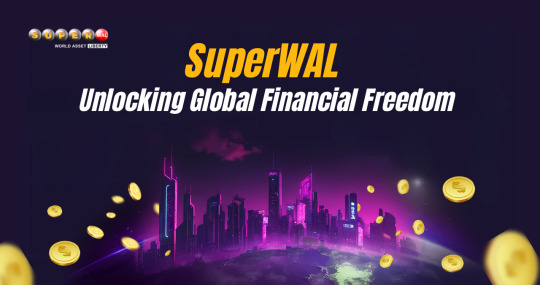
🌐 SuperWAL – The All-in-One Blockchain App for the Web3 Era
SuperWAL is a next-generation Layer 1 blockchain app developed by Aitekventure Ltd., combining Stellar Consensus Protocol (SCP) and ZK-Rollup. It aims to build a decentralized Web3 ecosystem that bridges digital and real-world assets (RWA).
🔹 Key Features:
Walchain Blockchain: Ultra-fast (~2s/transaction), near-zero fees.
SPL Token: Used for payments, staking, mining rewards, and governance.
Web3 Ecosystem: Includes DeFi, NFTs, GameFi, AI, DID, and SocialFi.
Multi-chain Bridge: Connects Ethereum, BSC, Solana, and more—no EVM required.
💸 Why Join SuperWAL:
Mine SPL for free daily.
Boost mining speed via SuperUP or referrals.
Transparent trading through the decentralized WaLX Exchange.
Global community with rewards, airdrops, and growth opportunities.
🚀 Get Started:
Download the SuperWAL app, sign up and verify your email, start mining SPL, and enjoy earning, exchanging, and using your tokens with ease.
SuperWAL – More than a blockchain. It’s a global Web3 revolution. 👉 Join now and unlock your financial potential!
1 note
·
View note
Text
Crypto, Stocks, or Real Estate? Here’s Where Smart Money is Moving Now
In today’s economic landscape, the million-dollar question isn't just how to invest—it's where the smart money is moving. With markets shifting faster than ever, wealth builders who follow the right signals can unlock massive gains… while others are left playing catch-up.
So if you're sitting on capital—whether it's $1,000 or $100,000—the time to decide is now.
Let’s break down where high-level investors are putting their chips in 2025: crypto, stocks, or real estate—and how you can strategically position yourself.
🚀 Crypto: The High-Risk, High-Reward Frontier
Where It Stands
After a rocky 2022–2023, crypto is maturing. The 2024 bull run, fueled by Bitcoin ETFs and institutional adoption, has rekindled public interest—but this isn’t the wild west anymore.
Today’s winners aren’t meme chasers. They’re early adopters of real utility: AI-integrated tokens, DeFi protocols, and projects with genuine scalability.
Where Smart Money’s Moving in Crypto
Ethereum Layer 2s like Arbitrum and Optimism
AI x Blockchain fusion projects
Tokenized real-world assets (RWA) — a breakout trend
✅ Pros
Huge upside potential
24/7 global market
Fractional, low-barrier entry
⚠️ Cons
Volatility is brutal
Regulatory risks
Still speculative—pick wrong, lose fast
Investor Playbook: Allocate 5–15% of your portfolio to crypto, focusing on projects with real-world use and developer traction.
📈 Stocks: The Reliable Growth Engine
Where It Stands
The S&P 500 has bounced back stronger than expected, driven by AI, green energy, and tech consolidation. Dividend stocks are also seeing a resurgence as more investors look for stable yield in uncertain times.
Where Smart Money’s Moving in Stocks
AI leaders like Nvidia, AMD, and Palantir
Green energy ETFs
Dividend aristocrats for cash flow
✅ Pros
Strong long-term historical returns
Regulated, transparent markets
Ideal for dollar-cost averaging
⚠️ Cons
Slower returns than crypto
Inflation can erode real gains
Susceptible to economic shifts and rate changes
Investor Playbook: Keep 50–70% of your portfolio here if you’re seeking balanced growth. Use index funds or build around megatrends (e.g., tech, AI, sustainability).
🏠 Real Estate: The Physical Power Play
Where It Stands
While high interest rates shook the housing market in 2023, smart investors didn’t panic—they pivoted. Now in 2025, demand for multi-family rentals, short-term vacation properties, and out-of-state investing is heating up.
With interest rates stabilizing and rents continuing to climb, cash flow-focused real estate is making a major comeback.
Where Smart Money’s Moving in Real Estate
Cash-flow rentals in undervalued markets (e.g. Midwest, Southeast U.S.)
Airbnb/STR in travel-friendly zones
Real Estate Investment Trusts (REITs) for passive players
✅ Pros
Tangible, appreciating asset
Passive income through rent
Powerful tax advantages
⚠️ Cons
High upfront capital
Illiquid
Property management headaches
Investor Playbook: If you’ve got $25K+ to deploy and a long-term mindset, real estate is a power move. No time? Start with REITs or real estate crowdfunding.
🧠 Final Verdict: Diversify with Intent
So where’s the smart money going?
👉 All three—strategically. Wealthy investors are diversifying across asset classes, not going all in on one. It’s about calculated exposure: Asset ClassRiskRewardIdeal AllocationCrypto🔴 High🚀 Very High5–15%Stocks🟡 Medium📈 High50–70%Real Estate🟢 Low-Medium💰 Moderate-High20–40%
🔥 Your Move: Start with $100 or $100K
Whether you’re building from the ground up or managing a six-figure portfolio, the key is intentional, informed investment.
Don’t chase hype. Follow smart trends, proven strategies, and timeless fundamentals.
Now ask yourself:
“Where is my money working for me—and where is it just sitting?”
👉 Want a step-by-step beginner’s guide to building your wealth portfolio in 2025?
Click here to visit our website and grab it before it’s gone—wealth waits for no one.
1 note
·
View note
Text
Elixir 与 Solv 合作推出 SolvBTC.AVAX 模块化收益金库,通过 deUSD 为比特币带来 DeFi 收益
深潮 TechFlow 消息,5 月 18 日,DeFi 协议 Elixir 宣布与比特币质押协议 Solv Protocol 合作推出由真实世界资产(RWA)支持的模块化收益金库 SolvBTC.AVAX,为 BTC 带来真实收益。 据介绍,SolvBTC.AVAX 由 Elixir 联合 Sole、Avalanche、Euler、LFJ 和 Balancer 推出:Solv 提供自动化收益策略;Avalanche 提供高速执行层;Elixir 铸造 RWA 支持的 deUSD;Euler 通过贷款循环提高敞口;LFJ/Balancer 通过流动性挖矿复合收益。 该产品的核心收益来源包括 BlackRock 的 BUIDL 和 Hamilton Lane 的 SCOPE。用户通过单一代币 SolvBTC.AVAX 可获得 AVAX 奖励、Elixir 积分与 Solv 积分,实现…
0 notes
Text
Solv launches new Bitcoin yield product on Avalanche
Solv Protocol has launched a yield-bearing Bitcoin token on the Avalanche blockchain, giving institutional investors more exposure to yield opportunities backed by real-world assets, or RWAs. On May 16, the protocol unveiled SolvBTC.AVAX, a token that connects Bitcoin (BTC) to real-world assets like US Treasurys and private credit offered by BlackRock and Hamilton Lane. The new token was…
0 notes
Link
0 notes